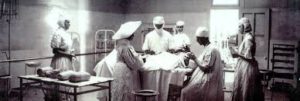Dr. J. W. Williams explains is own Plan — the story I call the “Dark Side of the moon:
I can imagine Dr. J. Whitridge Williams, as the former chief of obstetrics at Johns Hopkins University Hospital and current Dean of its world-famous medical school, having a sudden moment of inspiration in which the answer to his dream — a national system of full-service general hospitals — came to him all laid out and he jumped up from his chair and went running down the hall in a Eureka moment yelling:
“I’ve finally figured out it out!
If one of Dr. Williams colleagues had asked what he was so excited about, Dr. JWW would have said:
American hospitals are in big trouble and I finally figured out how to fix this critically important problem!
The problem I have been grappling so hard with is how to finance the modernization of American hospitals. The older, 19th-century pre-scientific model of hospital care — compassion hospitality for the ill and injured who can afford to it, but little or nothing to offer in the way of effective medical treatment — is financially unable to recreate themselves at the level of the scientific 20th-century modern hospital.
The newly scientific practice of medicine in the 20th-century is dramatically different than anything human beings have ever seen before or even imagined! Medical doctors now have the ability to prevent contagious diseases by using the newly-developed principles of antisepsis, diagnose and cure previously untreatable illness and injury, dramatically reduce suffering for those with terrible physical problems such as birth defects or disabling accidents and greatly improve the quality of life for those suffering from painful or debilitating chronic conditions.
What made these medical miracles possible are dozens of breakthroughs in the biological sciences in quick session over the last 50 years that has picked up speed in the last two decades, with no end yet in sight. This new information has re-written our medical textbooks and spurred the invention of new and undreamed of medical technologies that have become a critical part of implementing and extending the reach of this new scientific knowledge base.
At a practical level, 20th-century “modern” hospitals have to purchase new, capital-intensive scientific equipment. Their new clinical laboratories will need microscopes, sterilizers and an endless supply of test tubes and Petri dishes.
Their new x-ray departments must have one or more expensive x-ray machines, as well as leaded walls and lead aprons for self-protection, oceans of photographic film, chemicals and the facilities to develop the x-ray plates, and other ‘special’ (i.e. especially expensive!) supplies.
Their new or newly expanded surgery department will need ceramic tiled floors and floor-to-ceiling ceramic walls (better for washing down with strong disinfectants), more than one OR table and powerful overhead spotlights, several sterilizers for surgical instruments, and separate dressing rooms for doctors and nurses to undress and change into sterilized ‘scrub’ suits and special scrub sinks with foot-operated water facets.
They will need additional support services such as bigger better hospital laundries to clean and sterilize linens and a bigger kitchen to keep their patients and staff well fed. Last but certainly NOT least is a big and well-staffed central supply department charged with ordering tons of bandages and other medical supplies and a big industrialize-sized autoclave to sterilize equipment and durable supplies of any kind previously used by a patient (bedpans, etc) or otherwise become contaminated.
Then the hospital will need to hire, train and pay the salaries of professionals to run these new departments and safely use these new technologies. It’s highly likely that many of the thousands of one-room, 2-10 bed private hospitals will have to start their expensive modernization by first remodeling or building an addition on their hospital in order to house all these new services.
 Why this wonderful opportunity is simultaneously a big problem
Why this wonderful opportunity is simultaneously a big problem
But the so-called ‘business model’ of our American hospitals isn’t profitable enough to generate the kind of revenue stream needed to properly upgrade their own facilities. As a result, each these 8,000 or so hospitals and its surrounding community is stuck with a woefully — actually life-threateningly — inadequate pre-scientific 19th-century mode, with little or no hope of change in the foreseeable future.
Of equal or even greater concern, the individual inability of all these hospitals to upgrade their own facility to that of a full-service general hospital becomes a series of deadly missing links in the nationwide system. If the United States is to have a modern system of general hospitals as good or better (God willing!) than Western Europe, our country has to provide public access to acute medical and surgical services within a reasonable driving distance of every center of population greater than 3,000.
In my opinion, our current inability to successfully address this need is nothing more than a failure of imagination. Private hospitals in the US are stuck with an economic model proven centuries ago to be financially untenable, that is, counting on sick people to be able to pay for their hospital care.
Historically, general (i.e. acute-care) hospitals were seen as a ‘public service’, since the only other ‘option’ was to watch as critically ill poor people simply lay down on the sidewalk or street in the middle of town, moaning, writhing, wretching and usually defecating for several hours before they finally stopped breathing and died. Obviously, hospitals were a necessary adjunct to a civil society, and worth whatever financial cost that involved.
Since the 7th century in Western Europe (651 CE*) and the 18th century in the United States (1751*), the only viable financial support for general hospitals were charity institutions supported by donations to the Catholic Church and run by religious orders, or state and local governments that used public funds to pay the hospital’s staff and other costs of doing business. For example, the Emperor Charlemagne of the Franks (742–814) decreed that a hospital be attached to each cathedral and monastery to be sure the needy public were served in an orderly fashion. {**see references below}
The population of the United States has the same medical needs and expectations as our relatives and ancestors who immigrated from Europe — that is, dependable access to a nationwide system of general hospitals that are at least as good (if not better!) than the ones in Western Europe that provide this life-saving service to all its residents.
However, speaking as a patriotic American, I am well aware that to match or exceed (God willing!) the European system, the United States must take a dramatically different approach to financing this long-term humanitarian venture, one so vital to the health and well-being of our country and its people. Unlike the Europeans, our new system must never depend on public funding, either in its creation or its long-term maintenance.
Unfortunately, America hospitals are still stuck with a failed business model that depends on sick people as paying customers. Or this problem could be re-defined as not enough really rich sick people, while at the same time, there are far too many poor people who get really sick. This is just a demographic reality that is true all over the world — the number of wealthy people is never more than a small fraction of the population as a whole.
The 8,000 or so very small-to-medium-sized private hospitals in the US are losing money hand-over-fist at the very same time they need to be pouring large amounts of money into capital improvements. We cannot realistically expect these tiny private hospitals to pick themselves up by their bootstraps and overnight turn into models of scientific progress. Obviously, we must look for more innovative ways to underwrite this large, long-term and very expensive (but vital) project.
No Tax-based Public Funding in US
H owever, the answer which springs to the minds of most people and generally works in the European system — tax-supported public funding — is not an option in the United States.
owever, the answer which springs to the minds of most people and generally works in the European system — tax-supported public funding — is not an option in the United States.
American doctors in general and organized medicine in particular is justifiably opposed to any kind of a nationalized hospital system by state, federal or local governments. We cannot expect tax-based public funding to pay for the needed renovation and numerical expansion of our general hospital system, or in any other way to pay for directly or underwrite the provision of medical services to indigent populations. There are many very good reasons for this, but its a topic too complex to explain here.
What the country desperately needs is an upgraded and modern medical services delivery system (MxSDS) that includes a nationwide system of full-service general hospitals able to match the efficient models developed in Western European over the last two centuries. Nonetheless, the nationalized government-funded model used in Europe is not applicable to the United States.
 Changing one’s mind makes it all work out!
Changing one’s mind makes it all work out!
Doctor-owned small private hospitals and salaried administrators of medium-sized community hospitals need to modernize the way they think about the 20th-century practice of medicine and how they generate income.
Specifically, they need to re-examine their limited and limiting ideas about wh0/what is suitable a “hospital patient”, and also rethink how their institutions might maximize revenue in other areas, such as outpatient services and even profitable opportunities to generate revenue from non-medical services.
%%%%%%%%%%%%%% edit line as of 5 pm 03-16-2018 %%%%%%%%%%
What’s missing from the failing business model of hospitals that depending on sick people is a market-driven approach that stretches itself enough to go hog-wild and invent a brand new profit-generating demographic for hospital services.
Instead of thinking of their daily patient census as limited to the extremely ill and injured — patients that might not make it through the night or might linger for months before they either died or got discharged and may be paid their bill but far too often could not.
What if you went big and bold and added a brand new category of hospital patient — healthy, relatively wealthy people that agreed to be electively hospitalized in return for some hospital service that was relatively inexpensive to provide but that could be billed at the same 24-hour room rate as much sicker patients?
One particularly relevant demographic for this new category of the electively hospitalized healthy person is health maternity patients and their newborn babies. Unlike illness, which is seasonal and unpredictable, and injury which is erratic and unpredictable, childbirth, postpartum care for new mothers and hospital nursery care for newborns is a steady, dependable and a stable year-round source of patronage, thus providing the bread and butter income for hospitals.
It perfectly fits the description of the type of hospital care that was more in the category of ‘hospitality’ — a medical hotel with room service, since healthy new mothers are not sick, they did not need a lot of intensive nursing care, can walk to the bathroom, and the like.
Equality relevant is the issue of ‘repeat business. Critically ill and injured hospital patient that die therefore we can be absolutely sure that whole category never shows up as a satisfied customer with repeat business. And things are not that much different for kids with pneumonia, people who have a heart attack, break a leg, get mangled in some kind of farm machinery, thrown from their horse or run over by a car.
But childbearing women in the US in the early half of the 20th century had an average of 6 babies. As middle and upper-class wives, they had husbands with full-time jobs or independent wealth. This category of the electively hospitalized patient was the perfect cash cow for generating a steady and dependable revenue stream that far exceeded the expense of maintaining a lying-in (i.e. maternity) ward.
I carefully researched the birth rate of the average county and found the number enlightening. Most counties in the US have a population of approximately 20,000 inhabitants, with approximately 700 birth registered each year. I calculated that if even half of these childbearing women (350) could be convinced to have babies in the hospital (with husbands who agreed and were able to pay), it would create a solid economic basis for the business model of lying-in hospitals.
The standard hospital stay for mothers is 14 days, with another billable 14 days for the baby’s stay in the nursery. This would generate a minimum of 9,800 patient-days of business every year. With this kind of dependable patronage, lying-in hospitals would be able to “… provide laboratory, x-ray and other services necessary to provide for a well-equipped surgery department”.
Electively hospitalizing healthy maternity patients instantly and permanently changed the business model of American hospitals from one that at best was hanging on by its fingernails to gratefully welcomed financial solvency for hospitals that adopted the new market-based model.
Hospital administrators, who had been depending solely on sick people for income (established centuries ago to be a failed business model), immediately realized the benefits of expanding their hospital’s acutely-ill patient census to include a large percentage of ‘paying customers’.
This market-based model would provide a healthy profit margin simultaneously making up for less profitable hospital services (sick people who couldn’t pay), while eventually allowing them to invest in capital improvements such as new construction and upgraded equipment.
Last but certainly important is how electively hospitalized healthy maternity patients positively impacted the public narrative about hospitals. It was natural for people to think of hospitals as a place of last resort — people only went to a hospital if something very bad happened to they were critically or terminally ill. In short hospitals were places to die if
which will produce a reliable revenue stream that would covert general hospitals from money-loser to money-makers.
In my moment of inspiration, a revolutionary new business model came to me that will bring American hospitals into the 20th century and over the next century, turn general hospitals into profit-making centers for all forms of allopathic medical care and all aspects of healthcare in their community. In a hundred years, hospitals all over the country, in big cities and small towns be —-??? medical services delivery system, efficiently providing all aspects of health care.




